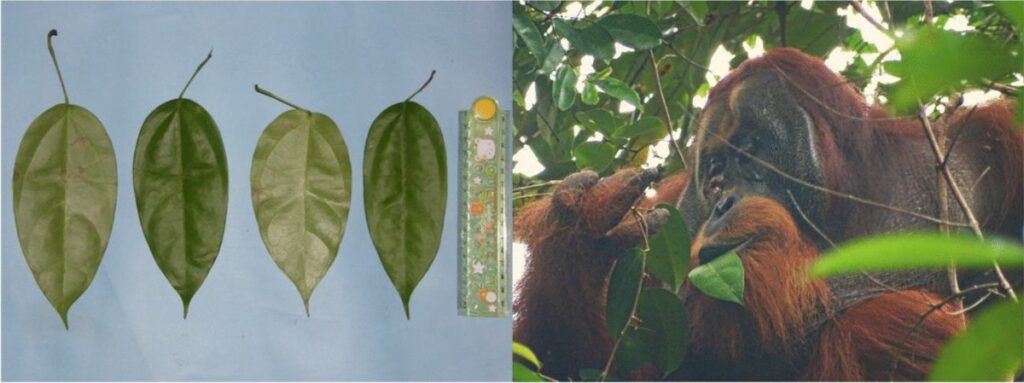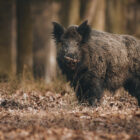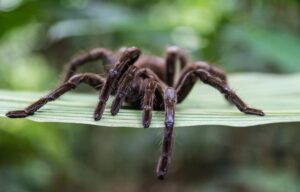Do animals self-medicate?

One phenomenon that has garnered increasing attention in recent years is animal self-medication – the practice of using natural substances or plants to treat illnesses, wounds, and other health issues. While it may seem like a uniquely human trait, research suggests that many species engage in this behavior, often with surprising sophistication.
From primates rubbing millipedes on their fur to repel insects, to birds lining their nests to ward off parasites, animals have been observed using various substances and plants to promote health and well-being. But what drives these behaviors? Is it simply a matter of instinct, or are there more complex cognitive processes at play?
The Case of Rakus The Orangutan
The story of Rakus, a male Sumatran orangutan, is the most recent example of animal self-medication behavior. Researchers observed Rakus treating an open facial wound with sap and chewed leaves from the plant Fibraurea tinctoria. This unique behavior demonstrated not only intelligence but also problem-solving skills.
Rakus’ wound was likely caused by a conflict or injury sustained in his natural environment. The orangutan’s response to this injury is noteworthy, as it suggests that he had learned to associate the sap and leaves with pain relief and healing properties. This association may have been formed through observation of other animals using these plants for medicinal purposes.
The use of Fibraurea tinctoria by Rakus is particularly interesting due to its well-documented traditional uses in human medicine. The plant contains a range of bioactive compounds, including antibacterial, anti-inflammatory, and antioxidant properties. These substances have been shown to possess therapeutic effects, such as reducing inflammation and promoting wound healing.
The observation of Rakus’ self-medication behavior raises questions about the origins of human wound care practices. It is possible that early humans learned from observing animals like orangutans using plants for medicinal purposes. This idea is supported by studies suggesting that primates have been observed engaging in behaviors similar to those used in traditional medicine, such as applying plant extracts to wounds.
Zoopharmacognosy, or Animal Self-Medication
Zoopharmacognosy is the study of animal self-medication behavior, which involves animals using plants or other substances to treat their own health issues. This field of research has gained significant attention in recent years as scientists seek to understand how animals are able to identify and utilize medicinal properties from various sources.
One of the key findings in zoopharmacognosy is that many animal species exhibit self-medication behaviors, including primates, birds, reptiles, amphibians, fish, and even insects. For example, some species of monkeys have been observed using plants with anti-inflammatory properties to treat wounds or injuries.
Another important aspect of zoopharmacognosy is the concept of “animal intuition.” This refers to an animal’s ability to recognize and respond to specific plant compounds that possess medicinal properties. Research has shown that animals are able to identify these compounds through a combination of visual, olfactory, and tactile cues.

Self-medication in Chimpanzees
Wild chimpanzees have been observed engaging in unique behaviors to manage their health. One such behavior is self-medication using plants containing compounds with medicinal properties.
One example of this is the use of Aspilia leaves, which contain thiarubrine-A, a chemical active against intestinal nematode parasites. Chimpanzees will collect these leaves and roll them around in their mouths for extended periods before swallowing them whole. This behavior allows the trichomes on the leaf surface to attach to any intestinal parasites present, facilitating physical expulsion of the parasites.
This self-medication behavior is particularly common during the rainy season when there is an increased risk of infection due to the abundance of parasitic larvae. In fact, chimpanzees may use as many as 15-35 Aspilia leaves in a single bout of this behavior.
Another plant used by wild chimpanzees for self-medication purposes is Desmodium gangeticum. The rough surface or sharp edges of these leaves are not chewed and excreted whole, indicating that they were ingested for medicinal rather than nutritional purposes. This leaf-swallowing behavior is also restricted to the rainy season when parasite re-infections are more common.
Interestingly, parasitic worms (Oesophagostomum stephanostomum) have been found together with these leaves in faecal samples of wild chimpanzees, suggesting that this self-medication behavior may be an effective way for them to manage intestinal parasites.
Self-medication by Ingestion
In addition to chimpanzees and bonobos, many other mammals have been observed engaging in self-medication behaviors.
One example is found among baboons (Papio anubis) and hamadryas baboons (Papio hamadryas). These primates are known to eat plants that contain secondary compounds with antiparasitic properties, such as tannins or alkaloids. In one study, researchers observed a group of hamadryas baboons in Ethiopia eating the leaves of the plant species Acacia tortilis (a type of acacia tree) when they were infected with gastrointestinal parasites. The same behavior was also seen among chimpanzees and bonobos.
Another example is found among ruminant mammals, such as sheep (Ovis aries), goats (Capra hircus), and cattle (Bos taurus). These animals are known to eat plants that contain secondary compounds with antiparasitic properties. For instance, when lambs were fed food containing tannins or oxalates, they would preferentially choose to eat the specific compound known to rectify their state of malaise induced by the food previously ingested. This suggests that these animals are capable of self-medicating against gastrointestinal parasites.
In addition to primates and ruminant mammals, laboratory mice (Mus musculus) have also been observed engaging in self-medication behaviors. When kept in standard cages without enrichment, mice can develop abnormal behaviors indicative of emotional disorders such as depression and anxiety. To improve welfare, these cages are sometimes enriched with items such as nesting material, shelters, and running wheels.
Finally, crested porcupines (Hystrix cristata) in Italy have been observed engaging in self-medication behaviors during the cold and rainy seasons when they are infected by various ectoparasites and endoparasites. During this time, these porcupine populations actively sought out a variety of medicinal plants with antiparasitic properties to consume. When ingested, these plants appeared to be relieving symptoms of infection such as inflammation.
Self-medication by Topical Application
A female capuchin monkey in captivity was observed using tools covered in a sugar-based syrup to groom her wounds and those of her infant. This behavior demonstrates self-medication for wound care, where the monkey is applying a topical treatment to promote healing.
Rakus, the male Sumatran orangutan, intentionally used leaves from the Fibraurea tinctoria vine to apply masticated plant material to an open wound on his face. The plant’s antibacterial, anti-inflammatory, and antioxidant properties likely contributed to the wound’s rapid healing within five days.
Insect Repellency
North American brown bears (Ursos arctos) make a paste of Osha roots (Ligusticum porteri) and saliva, which they rub through their fur to repel insects or soothe bites. The plant contains 105 active compounds, including coumarins that may repel insects when topically applied.
Similarly, primates have been observed rubbing millipedes onto their fur and skin, as the millipede secretions contain benzoquinones, potent insect repellents. This behavior not only provides protection from biting insects but also has psychoactive properties, suggesting a potential recreational use in animals.
Anting
Birds are known to engage in anting, where they wipe ants onto their feathers or roll in ant hills to repel feather lice and other parasites. The formic acid secreted by the ants is harmful to these pests, providing an effective natural defense mechanism.
Some birds have been observed selecting nesting materials rich in anti-microbial agents to protect themselves and their young from infestations or infections. For example, European starlings preferentially line their nests with wild carrot (Daucus carota), which has been shown to reduce the emergence of mite instars in laboratory studies.
Insecticide Application
Titi monkeys have been observed rubbing leaves containing insecticides like dillapiole and phenylpropanoids on their furs and abdominal areas. This behavior is likely a preventative measure to ward off insects, demonstrating self-medication for pest control.
Additionally, another species of titi monkeys has been seen rubbing their furs with the leaves of Psychotria, which contain antiviral, antifungal, and analgesic properties.










